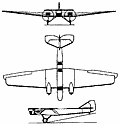 |
Tupolev ANT-4 / TB-11925 |  |
| BOMBER, TRANSPORT | Virtual Aircraft Museum / USSR / Russia / Tupolev |
 |
A cantilever low-wing monoplane powered by two 336kW Napier Lion engines, the prototype TB-1 or Tupolev ANT-4 made its maiden flight on ski landing gear on 26 November 1925. Intended mainly for the heavy bomber role, the ANT-4 was of all-metal construction with corrugated metal sheet covering and a glazed nose section. The aircraft was heavily influenced by Junkers, the German company that was unsuccessfully trying to sue Tupolev for patent infringements. The second aircraft was the true TB-1 bomber prototype; flown initially in July 1928 it had a redesigned nose section with 'balcony'-type gunner's cockpit and a crew of five including three gunners, and was powered by two 544kW BMW VI engines. A third prototype, designated ANT-4bis, had revised engine nacelles and increased armament. The first series machine was completed as a propaganda aircraft; named Strana Sovietov (Land of the Soviets) it was equipped for a staged flight across Siberia and on to New York but was soon damaged severely in a forced landing. A second aircraft was prepared and completed the journey, using wheels or floats as appropriate, and this second Strana Sovietov covered 21242km between leaving Moscow on 23 August 1929 and arriving in New York on 1 November. Production of the TB-1 continued until August 1932, a total of 152 being delivered plus 66 TB-1P twin-float bomber/torpedo seaplanes. These were built at the Fili works, where Junkers production was terminated to make way for the new indigenous aircraft. The ANT-4s were front-line equipment for a number of years before being relegated to the transport role with the revised designation G-1. Many were used as freighters by Aeroflot and by the Soviet Arctic Aviation Authority (Aviaarktika), final examples of the type being grounded in 1945. The TB-1 was also used in a number of experiments, including autopilot and drone trials, inflight refuelling of other aircraft, rocket-assisted take-offs, cargo parachute drops, and Zveno trials with parasite fighters. It was the first twin-engined all-metal cantilever monoplane to enter production in the world. Tupolev ANT-4 / TB-1 on YOUTUBE
|  COMPANY PROFILE | ||||||||||||||||||||||||||||||||||||||||||||||||||||||||||
 |

|

